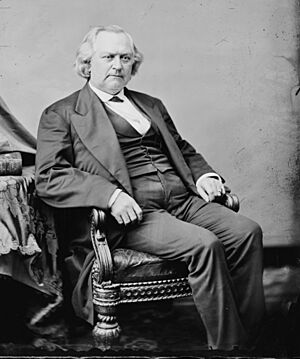Numaga facts for kids
Quick facts for kids
Numaga
|
|
|---|---|
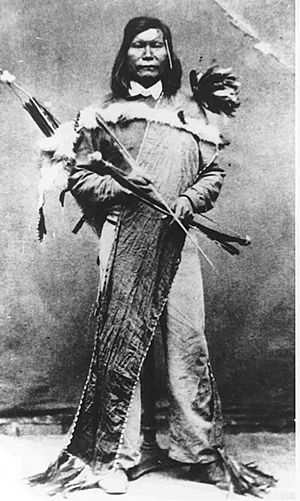
Numaga
|
|
| Born | circa 1830 |
| Died | 5 November 1871 (aged 40) |
| Occupation | Indian leader |
| Known for | Pyramid Lake War |
Numaga (born around 1830 – died November 5, 1871) was an important leader of the Paiute people. He lived during a time of big changes for his people. He is best known for his role in the Paiute War of 1860. This conflict happened near Pyramid Lake in what is now Nevada, USA.
The war started because many miners and ranchers moved into Paiute lands. They came after silver was found in the Comstock Lode. These newcomers often hurt the Paiutes and destroyed their food sources. When the Paiutes fought back, the U.S. Army got involved. Numaga always worked for peace, both before and after the war. He helped reduce fighting on both sides. He passed away in 1871 from tuberculosis.
Contents
Numaga's Early Life and People
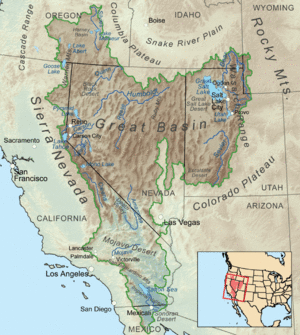
The Paiute people traditionally lived by hunting and gathering food. Their home was the Great Basin region. This area covers most of modern-day Nevada and western Utah. It stretches north into Oregon and is bordered by the Sierra Nevada mountains in California.
The weather in the Great Basin can be very hot in summer and very cold in winter. The land is mostly dry. It has thick forests on the mountains and thinner woodlands lower down. There are also grasslands, sagebrush, and bare, rocky areas.
The Paiutes did not have one central government. Instead, they lived in small groups of about 100 people. Each group used a territory of about 50 to 100 square miles. They moved with the seasons, living in temporary huts made from willow poles and reeds. They ate plants, roots, fruits, fish, ducks, lizards, and insects. In the fall, pine nuts were a very important food. In winter, they hunted animals like rabbits.
Numaga was born around 1830. Some people said he was the son of Chief Winnemucca (also known as Po-i-to). Others, like Sarah Winnemucca, said he was her cousin. Numaga was a tall man, over six feet, and very strong. He had a calm and thoughtful way about him. A soldier who met him in 1860 said he looked very wise and serious.
At first, contacts between the Paiutes and white fur traders were friendly. But after the California gold rush began in 1848, many more white people came. This made the Paiutes more cautious. Numaga learned English by working for some time in California. He was known for being honest, smart, and brave. White settlers saw him as a leader, even though he didn't have an official title among his people.
Reasons for Conflict
In 1859, a lot of silver was found in the Comstock Lode. This was in a region that would soon become Nevada. Many miners rushed to Virginia City, near Carson City. These miners cut down many pinyon trees for fuel. This destroyed the pine-nut "orchards" that were vital for the Paiute's food supply.
Hunters and trappers also took a lot of game, fish, and waterfowl to feed the miners. Ranchers moved into the fertile valleys. This blocked the Paiutes from reaching places where they gathered nuts, roots, and seeds.
In late 1859, two miners were killed. Their money was stolen, but not their clothes. This made people wonder if Native Americans were truly responsible. Major William Ormsby asked Chief Winnemucca (Poito) for help. Poito's daughter, Sarah, was staying with Ormsby to learn English.
Soon after, 100 Paiute warriors rode into Carson City. They were led by Chief Natchez and Chief Numaga. Natchez was the peace-chief, and Numaga was the war-chief. Numaga agreed to help find the killers. He sent men to ask the Washoe leader, Captain Jim, to give up the guilty men. Two Washoe men were sent for trial. Sadly, an angry crowd of white settlers shot them dead in front of Numaga.
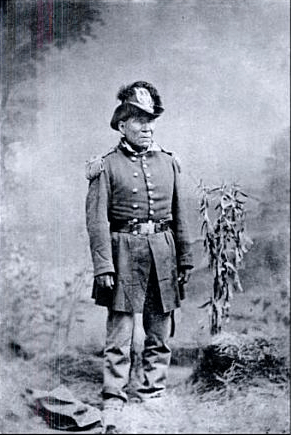
The Paiutes and Washoes faced starvation in the winter of 1859–1860. More and more fights broke out between white settlers and Native Americans. In April 1860, the Paiutes gathered at Pyramid Lake. They held a meeting to decide how to deal with the white settlers. Most leaders wanted to go to war. Chief Winnemucca, the most senior leader, seemed to favor war but didn't say so publicly.
Numaga was the only chief who spoke for peace. He knew more about the white settlers' strength from his time in California. He agreed that the white men had treated the Paiutes very badly. But he warned that the white settlers would surely win any war. He argued that a peaceful path was wiser. This would help the Paiutes keep their lands.
While Numaga was speaking, news arrived about an event at Williams Station. After hearing what happened, Numaga said, "There is no longer any use for counsel; we must prepare for war, for the soldiers will now come here to fight us."
The Pyramid Lake War
The conflict began on May 12, 1860. Two Paiute women were captured by five men at Williams Station. This was a Pony Express post on the Carson River. A group of Paiutes attacked the post, killed the men, and freed the women. Major William Ormsby gathered 105 volunteers from Virginia City. They went to bury the dead and punish the Paiutes at Pyramid Lake.
The Paiutes, led by Numaga, drew this group into a dangerous spot. The volunteers had handguns, while the Paiutes had long-range rifles. The white volunteers were outsmarted. Most of them were killed, including Ormsby, in what is now called the Battle of Pyramid Lake. Seventy-six of Ormsby's men died, and most of the rest were wounded. Nightfall saved those who survived. This defeat by the Paiutes greatly affected the white settlers' morale.
An army officer arriving after the battle saw a lot of fear. Many people were returning to California to avoid the Paiutes. Soldiers and volunteers were gathered to fight an estimated 15,000 "Pah Utes, Shishones and Pitt River Indians." News of attacks by Native Americans was common. Colonel Jack Hays, a former Texas Ranger, took command of the U.S. forces. Hays gathered over 750 soldiers and volunteers. They left California on June 2, 1860.
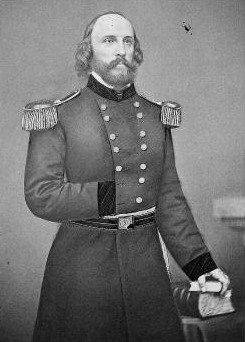
Hays fought the Paiutes in two small battles near Pyramid Lake. Neither battle was a clear win, but the Paiutes suffered enough losses. Numaga's loosely organized command broke apart. The Paiute groups scattered into the Black Rock and Smoke Creek deserts and nearby hills. Some went further into Oregon, Idaho, and Washington Territory. The war slowly ended.
U.S. troops built a temporary fort near Pyramid Lake. Later, they moved to Fort Churchill. This fort protected the wagon trail from the east. There was a small fight with soldiers led by Frederick W. Lander. Lander was an Army engineer building a wagon road. He saw the fighting as a distraction. He started a truce with Numaga that led to lasting peace.
Working Towards Peace
Lander's assistant captured five Northern Paiutes. He released two of them. They promised to return with their leader, Naanah. Lander and Naanah met on August 12. They agreed that Naanah would bring Numaga to a meeting at Deep Hole Springs.
On August 21, 1860, Numaga met Lander. After eating food from Lander's men, they talked. Lander said he could tell Numaga's complaints to the "Great Father" (the President) in Washington. But he could not make any promises.
Numaga said he was glad Lander made no promises. He explained that white people had never kept their promises before. He also said he could not stop all Paiute groups from attacking. Just as the "Great Father" could not stop white people from killing Native Americans. He believed the violence came from the hostile actions of white settlers. They had harmed Paiute women and killed men for no reason. Numaga said he was not responsible for the Williams Station event. He blamed it on a group of Bannocks he did not control. But he said if the white settlers had talked to him afterward, as agreed by treaty, there would have been no fighting.
Lander asked Numaga to try and keep the Paiutes from fighting for a year. In return, Lander would try to arrange a treaty. This treaty would let the Paiutes keep their lands. Or they would be paid for lands taken from them. Numaga agreed. He said he would try to bring Poito to meet with Frederick Dodge, the Indian agent. This would set up a formal truce.
Later Years and Legacy
The agreement between Numaga and Lander worked well. In 1862, Winnemucca (Poito) and 400 warriors welcomed James W. Nye. Nye was the first governor of the new Nevada Territory. This happened at Pyramid Lake. Even though some fighting continued in later years, Numaga and Poito did not take part.
In 1863, Numaga went to Como, a town near Virginia City. He formally complained about the destruction of pine-nut trees. He explained that these "pine-nut groves were the Indian's orchards." They depended on them for food. He said white people could collect fallen wood, but must not cut down the trees. Numaga's words were ignored.
Later, there were rumors of Native Americans gathering to attack. Two citizens accidentally shot at each other in the dark, thinking they were fighting Numaga. A butcher also accidentally fired his gun. The next morning, Native Americans came to town to see what all the noise was about.
In March 1865, two white men were killed by Native Americans on the Walker River. Later, two more white men died in separate events. Settlers became very worried. Some newspapers even suggested getting rid of all Native Americans. Troops from Fort Churchill were sent out. They found a camp of cattle thieves near Mud Lake (also called Winnemucca Lake). Before dawn on March 14, 1865, the troops attacked the Paiute camp. Twenty-nine Paiutes were killed. The troops had only one minor injury.
To stop more violence, Governor Henry G. Blasdel asked for a meeting at Fort Churchill with the Paiute chiefs. Numaga explained what really happened. There had been cattle thieves in the camp, but they had left before the soldiers arrived. Besides three or four men, the camp mostly had women and children. This included Poito's wives, who were killed. Some women jumped into the water to escape. Those who didn't drown were shot. Numaga said the violence could have been avoided. If the white settlers had asked him, he would have given them the cattle thieves.
Numaga was highly respected by white settlers. His account of the Mud Lake incident differed greatly from the army's report. The army leader, Captain Wells, claimed his men fought a "stubborn and sanguinary" battle against equal forces. He did not mention any women being killed.
Between 1864 and 1868, there was ongoing fighting. This was between miners and settlers and the "Snake Indians" (groups of Northern Paiutes, Bannocks, and Shoshones). This happened in the Snake River and Owyhee River valleys. This conflict is sometimes called the Snake War.
Around June 20, 1866, General Henry Halleck visited Fort Churchill. Many Paiutes from the Truckee and Walker River reservations came to see him. Numaga was the main speaker. He spoke of friendship for the white settlers but also shared the Native Americans' complaints. The warriors with Numaga showed off their impressive horsemanship. Numaga said he would take all the Native American prisoners Halleck had captured back to the Truckee Reservation. He promised to watch over them there. The Native Americans also received food supplies.
Numaga died from tuberculosis on November 5, 1871. He passed away near Wadsworth, Nevada.
Images for kids


